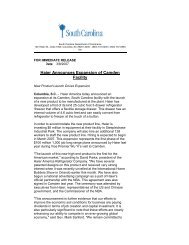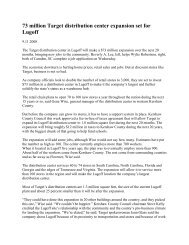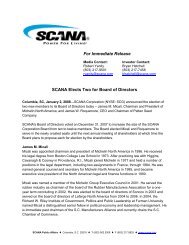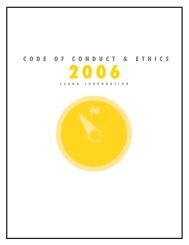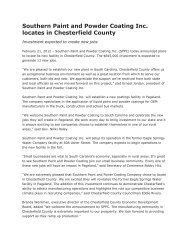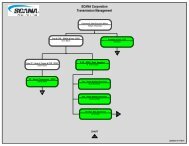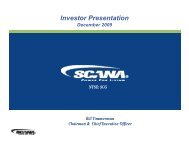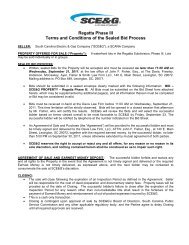SCEG OATT Formula Transmission Rate Filing.pdf - SCANA ...
SCEG OATT Formula Transmission Rate Filing.pdf - SCANA ...
SCEG OATT Formula Transmission Rate Filing.pdf - SCANA ...
Create successful ePaper yourself
Turn your PDF publications into a flip-book with our unique Google optimized e-Paper software.
20091231-0037 FERC PDF (Unofficia1) 12/29/2009<br />
Exhibit No. SCE-S(A)<br />
Summary: <strong>SCANA</strong><br />
Corp.<br />
Through <strong>SCANA</strong> Energy, <strong>SCANA</strong> is exposed to retail gas marketing operations in Georgia, serving abour 460,000<br />
customers, including about 95,000 customers under a provider-of-last-resort arrangement that includes low-income<br />
and high credit risk customers. <strong>SCANA</strong> Energy will hold this role as the provider of last resort through August<br />
2009. Standard & Poor IS views this operation as having significantly higher business risk compared to the regulated<br />
utility operations, stemming from the potential for customers to leave <strong>SCANA</strong> Energy for alternative suppliers as<br />
well as the challenge of matching supply and demand without any regulatory recourse for cost under-recoveries. The<br />
latter risk is partly mitigated by a significant percentage of customers who are on variable pricing plans that adjust<br />
monthly to reflect current market prices.<br />
<strong>SCANA</strong>'s consolidated financial risk profile is aggressive. For 2008, adjusted funds from operations<br />
(FFO) were<br />
$714.3 million and adjusted total debt was $5.16 billion. Credit metrics have weakened from prior years' levels, in<br />
large part due to a significant increase in debt to fund capital spending which totaled $914 million in 2008.<br />
Adjusted FFO interest coverage was 3.4x, adjusted FFO to total debt was 13.8% and adjusted total debt to total<br />
capital was 62.5%. The expected capital spending program is significant with about $1.2 billion annually in 2009<br />
and 2010 and $1.4 billion in 2011, a material portion of which will be for the proposed nuclear plants. The large<br />
capital spending program contributes to the aggressive financial risk profile and necessitates not only a balanced<br />
funding approach but, importantly, timely rate relief for both the nuclear construction<br />
construction<br />
to collect a cash return on<br />
work in process, but also through base rate relief to address the ongoing capital spending needs of the<br />
remaining company. Absent such relief, the financial profile C3n weaken further, placing additional downward<br />
pressure on ratings, even after accounting for the company's<br />
with equity issuances.<br />
plan to fund a portion of these capital expenditures<br />
Liquidity<br />
<strong>SCANA</strong>'s liquidity is adequate to meet capital spending and other needs. <strong>SCANA</strong>'s liquidity consists of $1.1 billion<br />
in revolving credit facilities (<strong>SCANA</strong>: $200 million, SCE&G: $650 million; and PSNC: $250 million) that expire in<br />
2011 and which had $564 million still undrawn. Liquidity also benefits from $272 million of cash on hand as of<br />
Dec. 31, 2008. Debt maturities are manageable and somewhat mitigate refinancing risk at least over the<br />
intermediate tern, with $144 million in 2009, $25 million in 2010, about $546 million in 2011, $275 million in<br />
2012 and $167 million in 2013.<br />
Outlook<br />
The stable outlook on <strong>SCANA</strong> incorporates expectations that the proposed nuclear construction proceeds on<br />
schedule and on budget within the SCPSC-approved scheduling and budget mechanism. In addition, the stable<br />
outlook incorporates expectations that the financial risk profile will remain aggressive with adjusted FFO to interest<br />
coverage of no less than 3.5x, adjusted FFO to total debt of 14% to 15%, and adjusted total debt to total capital<br />
that will begin to moderate from the end of 2008 levels of 62.5% as a result of retained earnings and proposed<br />
equity issuances to support the construction program. Ratings could be lowered if credit merrics underperform<br />
expectations principally as a result of waning regulatory support resulting in delays for the recovery of unanticipated<br />
capital expenditures for the nuclear construction or schedule delays that are deemed imprudent with associated costs<br />
not recovered. Therefore, FFO to interest coverage of less than 3.0x, FFO to total debt of lower than 14%-15% and<br />
debt leverage that increases above current levels of about 62.5% are pressure points towards lower ratings. Standard<br />
& Poor's does not currently contemplate a higher rating during the construction period, given the size and scale of<br />
the project.<br />
www.standardandpoors.com!ratingsdirecl<br />
Standafll & Poor's. All rights reserved. Nt) reprlRI or dissemination without S&P's ]l&I'fflissiOll, See Terms of Use/Disclaimer 0fI11le IClS1page.<br />
3



